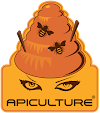
Bees for Development article on why bees need water.
Honeybees nesting in the wild choose nest sites close to water supplies. Beekeepers must ensure that honeybees kept in hives have adequate water supplies available. Honeybees cannot survive without water. These are the reasons:
1· Temperature and humidity control
Honeybee colonies must maintain their nest temperature around 35°C. Young bees developing in the brood nest need to be kept at the right temperature and humidity. If the nest temperature was allowed to rise without control. wax combs would melt and the colony would be reduced to chaos. Honeybees collect water to keep the colony cool: water is brought into the nest and evaporative cooling keeps temperatures down.
2· Brood rearing
Water is also needed for feeding developing bees. The brood food they receive is secreted by worker bees and contains 70% water. To produce this brood food, worker bees need to have honey, pollen and water.
3· The dilution of food sources
When bees feed on honey, sugar syrup or nectar supplies (containing more than 50% sugar) water is needed for dilution.
Water carriers
Some honeybees' main task in life is carting water. Each bee may make typically 50 trips a day, each time collecting about 25 mg of water. When the colony is very short of water other foragers will divert from collecting nectar and pollen to join in the effort.
How much?
In a very hot climate one colony will need several litres of water every day. To obtain two litres of water, bees will have to make around 80.000 water-collecting trips.
Sources of water
The ideal source of water is a permanent supply of clean, flowing water. Of course this is not always possible and if there is no permanent water source nearby (certainly within 0.5 km of the hive) beekeepers need to provide water for their bees.
Water provision
The container must be as large as possible, at least one metre in diameter. Bees find water sources by the increased humidity in the air above the water. Small dishes of water are therefore unlikely to be found by bees and similarly, supplies which are covered
· Wide mesh netting can be placed over water troughs for bees, to prevent other animals from using them.
· Bees drown if they become water logged. This is a risk if they are collecting water from an open water source. Provide plenty of floats in the water (straw, pieces of wood, cork, branches) for the bees to land on.
· Water sources should be as near to the colony as possible. The further it is from the hive. the greater the energy used by bees in obtaining water, and the smaller the honey surplus available to the beekeeper at the end of the season!
· Water sources should be as near to the colony as possible. The further it is from the hive. the greater the energy used by bees in obtaining water, and the smaller the honey surplus available to the beekeeper at the end of the season!
· Water must be clean. Normally surface tension prevents bees from sinking into water. but if there is any trace of detergent or other chemicals in the water, this can change the surface tension and cause bees to drown.
· Water sources must not be allowed to dry up = bees need water daily.
Water Feeders
If you have only a few colonies of bees then in hot weather it is possible to provide water inside the hive using a syrup feeder or other container devised to prevent bees drowning.
Other considerations
Bees are sometimes regarded as a nuisance when they obtain water from village water taps or bathing areas.
Sometimes bees can be enticed away by providing a slightly salted source of water. nearer to the hive. This substitute source must then be kept in continuous supply or the bees will return to their previous site.
If the source at which they have become a nuisance can be covered up, the enticing effect is more likely to work.
Once honeybees have located a good source of water they tend to continue using it, even when other sources become available.







No comments:
Post a Comment